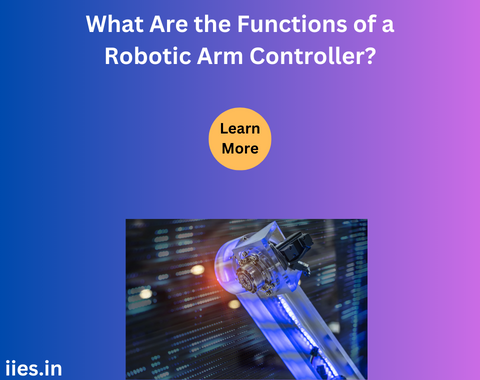
In the realm of advanced technology, robotic arms have become indispensable tools across various industries, from manufacturing and healthcare to space exploration and beyond. These robotic arms are highly versatile and capable of performing intricate tasks with precision. Behind their seamless movements and efficiency lies a crucial component known as the robotic arm controller. This article aims to delve into the intricacies of what a robotic arm controller is, its functions, and the pivotal role it plays in the seamless operation of robotic arms.
Robotic arms are employed in diverse applications, ranging from manufacturing processes, where they streamline production lines, to medical surgeries, where they enhance precision and minimize invasiveness. Their adaptability makes them ideal for tasks that are hazardous, repetitive, or require a level of precision beyond human capabilities.
Before we delve into the specifics of robotic arm controllers, it’s essential to grasp the fundamental concept of robotic arms. These mechanical devices are designed to replicate the functionality of a human arm, with joints and links that mimic the movement of shoulder, elbow, and wrist. The robotic arms are equipped with end-effectors, which are specialized tools or grippers tailored to perform specific tasks such as welding, painting, or assembly.
Robotic arms are employed in diverse applications, ranging from manufacturing processes, where they streamline production lines, to medical surgeries, where they enhance precision and minimize invasiveness. Their adaptability makes them ideal for tasks that are hazardous, repetitive, or require a level of precision beyond human capabilities.
The Role of Robotic Arm Controllers:
At the heart of every robotic arm system lies the robotic arm controller. This crucial component serves as the brain of the robotic arm, dictating its movements, actions, and responses. The robotic arm controller is essentially a sophisticated computer system that interprets commands, processes data, and orchestrates the coordinated motion of the robotic arm.
Key Components of a Robotic Arm Controller:
1. Microcontroller/Processor:
The microcontroller or processor is the central processing unit (CPU) of the robotic arm controller. It executes the instructions and algorithms that govern the movements and actions of the robotic arm. Advanced processors enable real-time processing, ensuring swift and precise responses to changing environments.
2. Sensors:
Robotic arms are equipped with an array of sensors that provide real-time feedback to the controller. These sensors include position sensors, force sensors, and vision sensors, allowing the controller to adjust the arm’s movements based on the surrounding conditions. This sensory feedback is crucial for tasks that require adaptability and responsiveness.
3. Actuators:
Actuators are responsible for translating the controller’s commands into physical movements. Electric motors or hydraulic systems are commonly used as actuators in robotic arms. The controller modulates the power and duration of these actuators to achieve the desired level of precision and force.
4. Programming Interface:
Robotic arm controllers come with a programming interface that allows engineers and operators to input commands and create sequences of actions. This interface can range from simple programming languages to more sophisticated graphical interfaces, making it accessible to users with varying levels of expertise.
Modes of Operation:
Robotic arm controllers operate in different modes, each suited to specific applications:
1. Manual Mode:
In manual mode, the operator directly controls the robotic arm using a joystick, touchscreen, or other input devices. This mode is useful for tasks that require a human touch or intricate manipulation beyond the capabilities of automated systems.
2. Semi-Autonomous Mode:
In semi-autonomous mode, the robotic arm operates under the guidance of the controller but allows human intervention for decision-making or adjustments. This mode is often used in scenarios where a combination of human expertise and robotic precision is required.
3. Autonomous Mode:
Autonomous mode enables the robotic arm to operate independently based on pre-programmed instructions or artificial intelligence algorithms. This mode is advantageous for repetitive tasks or processes that demand continuous operation without human intervention.
Applications of Robotic Arm Controllers:
The versatility of robotic arm controllers has led to their widespread adoption across various industries:
1. Manufacturing:
In manufacturing, robotic arm controllers streamline production lines, improving efficiency and consistency in tasks such as welding, painting, and assembly. The ability to operate continuously without fatigue makes robotic arms ideal for mass production.
2. Healthcare:
Robotic arms are employed in surgical procedures, where the precision and steadiness they offer are invaluable. Robotic arm controllers in the healthcare sector ensure that surgeons can control the movements with utmost accuracy, minimizing invasiveness and recovery time for patients.
3. Space Exploration:
Robotic arms equipped with specialized controllers play a vital role in space exploration missions. These arms are used for tasks such as deploying instruments, collecting samples, and conducting repairs on spacecraft.
4. Logistics and Warehousing
In logistics and warehousing, robotic arms controlled by sophisticated algorithms facilitate the automation of material handling, including picking and placing items in warehouses. This enhances operational efficiency and reduces labor costs.
Challenges and Future Developments:
While robotic arm controllers have revolutionized various industries, challenges persist, such as the need for enhanced adaptability in unstructured environments and improved human-robot collaboration. Future developments are likely to focus on incorporating artificial intelligence and machine learning algorithms into controllers, enabling robotic arms to learn and adapt to changing conditions autonomously.
In conclusion, robotic arm controllers stand as the unsung heroes behind the seamless and precise movements of robotic arms. Their intricate design, incorporating processors, sensors, actuators, and programming interfaces, enables the automation of a myriad of tasks across diverse industries. As technology continues to advance, the evolution of robotic arm controllers will play a pivotal role in shaping the future of automation, making processes more efficient, safer, and capable of pushing the boundaries of what is possible in various fields.
Indian Institute of Embedded Systems – IIES